#gatun lock
Photo
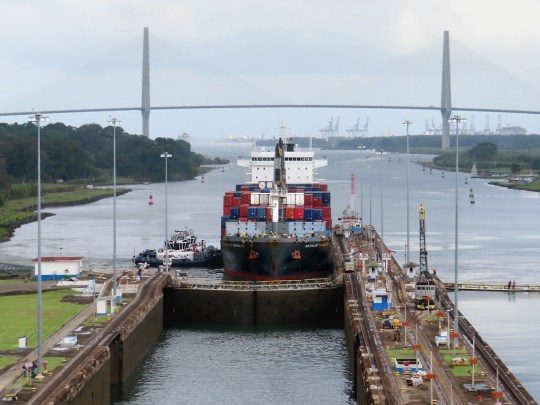
The container ship Mathilde Schulte enters the Gatun Locks of the Panama Canal with the Puente Atlántico (2019) in the background.
5 notes
·
View notes
Text
Day 6 - Passing through the Panama Canal
As I write this we are on Gatun Lake after passing thought the Gatun Locks which are located on the Atlantic side of the passage. These locks raised the ship 85 feet above sea level. The 48 mile canal was completed in 1911 at a cost of $400 million USD and currently accommodated about 11,000 ships per year. The transit fee is based on the ships tonnage and I was told that this ship paid $200k to make the passage. There are two sets of locks on the Pacific side of the canal that will lower us back to sea level. It will take about 10 hours to make the passage. I put some photos of ship moving through the Gatun locks below.


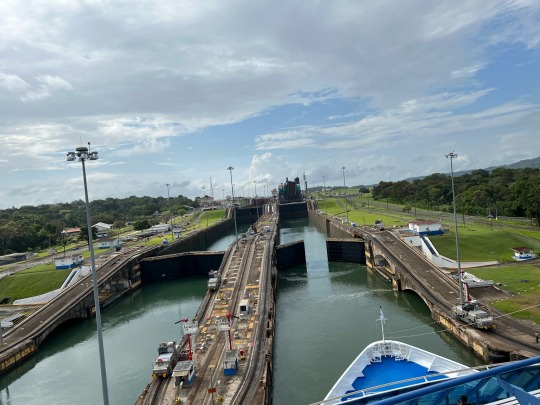




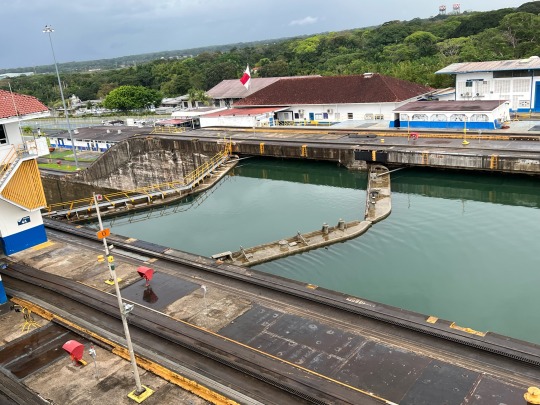
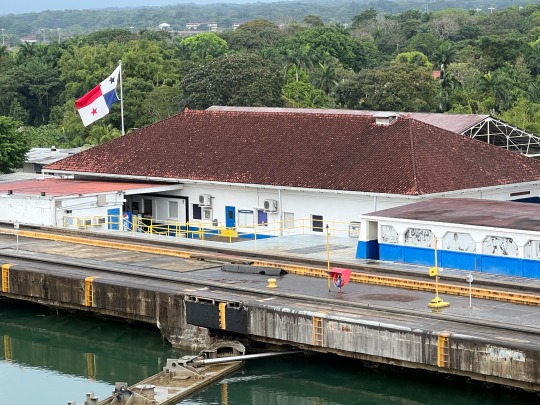
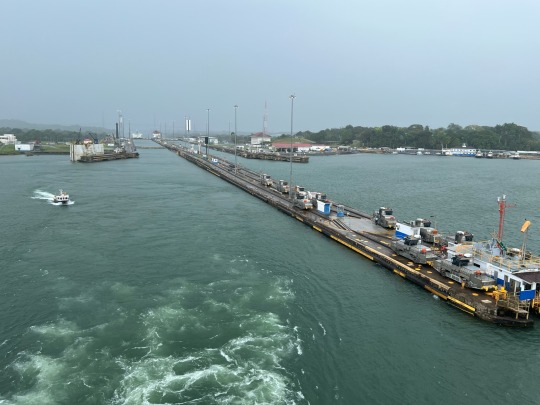
2 notes
·
View notes
Text
Day 8 of 15 Panama Canal...Our Fascinating Crossing of the Panama Canal, from the Atlantic to the Pacific
Friday April 28, 2023
Day 8 of 15…..Welcome to the Panama Canal. The whole purpose of the trip. Traveling from the Atlantic Ocean to the Pacific Ocean, going through 3 sets of locks.
Arrival 6am……..Departure 6pm.
PANAMA CANAL SCHEDULE
Gatun Locks ……6am
Pedro Miguel Locks…..1:30pm
Miraflores Locks……3pm
Finally, the day has come….. Traveling through the Panama Canal on our ship “Radiance of…
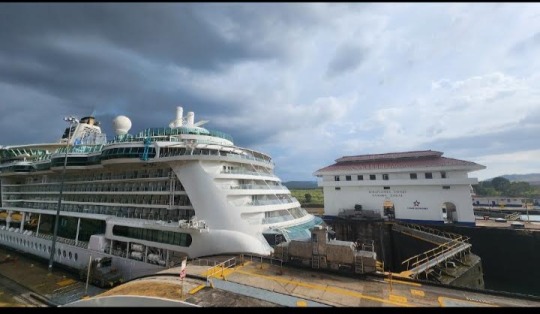
View On WordPress
#Gatun Locks#Imax The History of the Panama Canal#Lake Gatun#Mirafloras Locks#Panama Canal#Pedro Migiel Locks#Radiance of the Seas
0 notes
Text
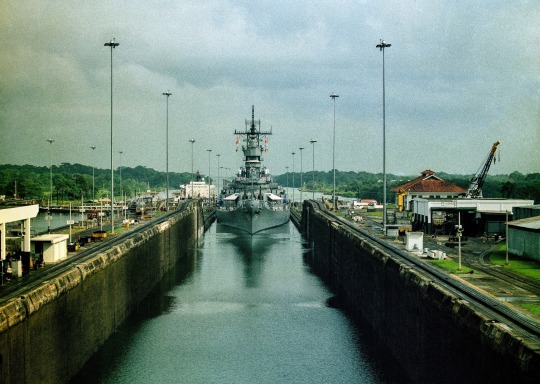
(12/10/1986) A bow view of the battleship USS MISSOURI (BB 63) transiting the Gatun Locks on the final leg of an around-the-world shakedown cruise USN Image tor: Carlos Drake
41 notes
·
View notes
Text
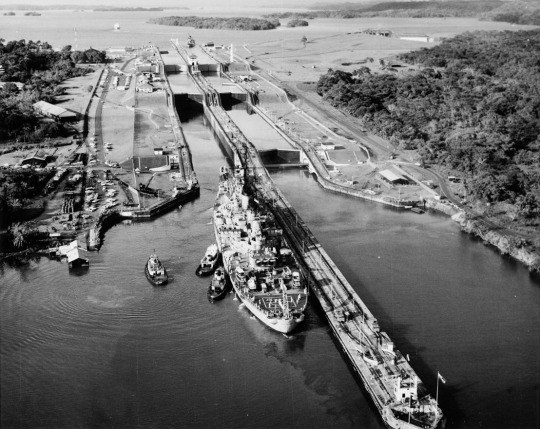
USS NEW JERSEY (BB-62) entering the Gatun Locks, Panama Canal.
Date: March 9, 1953
source
#USS New Jersey (BB-62)#USS New Jersey#Iowa Class#Battleship#March#1953#Panama Canal#Panama#warship#ship#United States Navy#U.S. Navy#US Navy#USN#Navy#Korean War#Korean Conflict#Cold War#Korea#my post
34 notes
·
View notes
Text
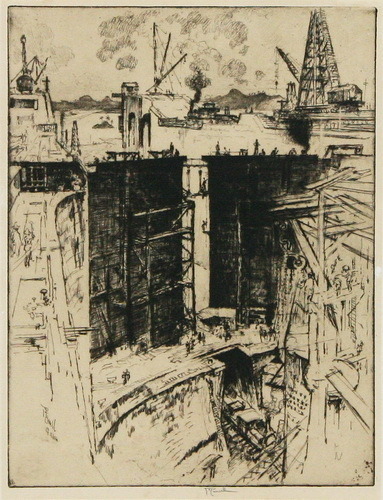
The Guard Gate: Gatun Lock
Joseph Pennell
Medium: Etching on paper
Size: 12 7/16" × 9 1/2"
Date: 1912
2 notes
·
View notes
Note
After attacking Pearl Harbor, why didn’t the imperial Japanese navy move to damage or destroy the Panama Canal? Wouldn’t that have given them longer to entrench themselves and build up their forces in the pacific?
A lack of craft capable of performing the attack. Surface ships would have been intercepted and attacked by ground-based air assets and coastal defense fleets, so the IJN designed a solution. The Japanese tried to develop a truly massive submarine capable of launching a floatplane. The plan was designed and several I-400 gigantic submarines were built with the intent to bomb the Gatun Lock, but the plans were scrapped because by the time everything was ready to go, it was 1945 and the Japanese were scrambling to attack the USN fleet assets amassing to attack the Home Islands.
Thanks for the question, Anon.
SomethingLikeALawyer, Hand of the King
29 notes
·
View notes
Text
Changing climate casts a shadow over the future of the Panama Canal – and global trade | Environment | The Guardian
The locking system relies on fresh water from Lake Gatun and another nearby reservoir to function. Every ship that passes through the canal uses 200m litres of water most of which then flows out into the sea.
The same sources also provide water for more than half of Panama’s 4.3 million inhabitants, forcing administrators to balance the demands of international shipping with the needs of the locals.
In normal times, the Panama Canal has capacity to handle 36 ships a day. But as water has grown scarcer, the canal authority has reduced that number to 22. By February, it will be just 18.
Those who rely on the route are left with no good options; they can wait up to weeks at a time to be allowed through the canal, pay up to $4m to jump ahead in the queue – or do what many shipping companies have been forced to and avoid the route entirely, adding days or weeks to their journey.
6 notes
·
View notes
Photo
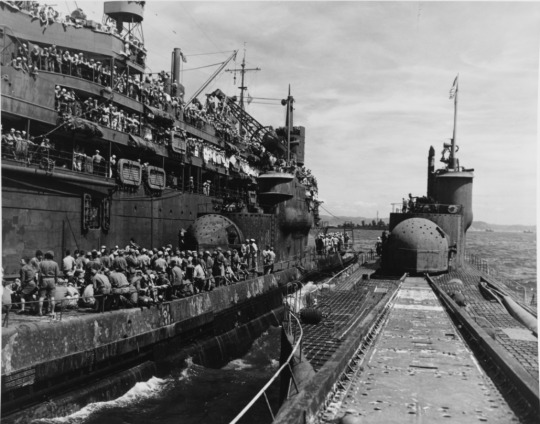
This Day in History: Japan attack on Panama
At about this time in 1945, Japan cancels a plan to attack the Panama Canal. The Japanese had new submarines—unlike anything the world had ever seen. They’d wanted to use them to destroy canal locks and keep the U.S. Atlantic fleet from traveling to the Pacific.
It was too late. The American presence in the Pacific was already overwhelming, so the Japanese switched their target: They’d aim for U.S. carriers at the Ulithi Atoll instead.
Do you know about the Japanese “super submarine” that was developed towards the end of World War II? That submarine was effectively an underwater aircraft carrier. It had been in the works for years. Originally, the Japanese thought this submarine would be used to attack the American mainland—even including targets as far away as New York City.
In the end, though, the Japanese decided that a single strike on the Panama Canal would be most effective. After all, if they knocked out the Gatun Locks, the canal would be useless for months.
The story continues here: https://www.taraross.com/post/tdih-japan-i-400
#tdih#otd#this day in history#history#history blog#America#world war ii#wwii#liberty#freedom#today i learned#sharethehistory
60 notes
·
View notes
Photo

On July 25, 1919, the USS New Mexico was pictured in Gatun Locks, Panama Canal. SSHSA Archives. #OnThisDay Search our online catalogue at https://sshsa.pastperfectonline.com/. Email [email protected] for research help. (at The Steamship Historical Society of America) https://www.instagram.com/p/CgcCXRBMtD2/?igshid=NGJjMDIxMWI=
3 notes
·
View notes
Text
Macaroons versus Monster Trucks
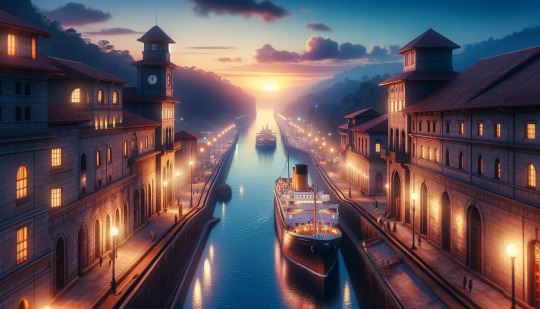
It was the best of times, it was the worst of times, it was the age of wisdom, it was the age of foolishness, it was the epoch of belief, it was the epoch of incredulity, it was the season of Light, it was the season of Darkness, it was the spring of hope, it was the winter of despair, we had everything before us, we had nothing before us, we were all going direct to Heaven, we were all going direct the other way – in short, the period was so far like the present period, that some of its noisiest authorities insisted on its being received, for good or for evil, in the superlative degree of comparison only.
Charles Dickens, A Tale of Two Cities, 1859
Other than the divergence from the myopia of prying apart the isthmus with a sea-level canal Washington also bested its fleur-de-lys counterpart with superior technology. The suite of machinery in America’s inventory had a material effect on the alacrity with which regolith and rock was removed from the bed of the waterway. Mythologized as a Goliath of steam and steel the Bucyrus dragline weighing ninety-five tons weathered the wear and tear of construction for a decade as it bent nature to its will. Sporting a bucket to accommodate five cubic meters of spoil with each bite into the ground and whose efficacy boasted a fivefold increase in productivity versus any French copy the machine expedited work by orders of magnitude (Parker 2009: 464). An army of these giants sitting atop rail tracks led the mechanized assault on the 50-mile trench together with a phalanx of trains in the vicinity of 160 each day which hauled the muck out to build the Gatun Dam. This grist sourced from the dig impounded an artificial lake that would later feed the lock system with a steady supply of water to make the Canal’s passage uninhibited. The bespoke Bucyrus made uniquely for this project pared down labour-intensity when the behemoth manipulated 4,800 cubic yards of material each day bereft of protracted downtime (Ryckman 2018).

Seven shovels of earth filled a rail car in under ninety seconds or forty-five minutes for a whole train whereby locomotives were kept in perpetual motion when each outbound trip greeted an inbound one (Rogers and Magura 2018). Such continuous kinetic energy militated against any gridlock which might cripple the venture’s lead time. This cavalcade of twenty buckets on four wheels that vacated ground zero took two hours to complete a circuit between the dumpsite and worksite (Giroux 2014). As the railroad expanded piecemeal into the inhospitable terrain a slight gradient always exploited gravity to help the departure of trains laden with rock and rubble. This innovation equally allowed for drainage to keep the roadbed dry for the maze of tracks crisscrossing the Panamanian jungle. Where the French most acutely erred was in their logistics which saw a mismatch between the mounds of earth removed and their disposal. By contrast Chief Engineer John Stevens devised 450 miles of railway akin to a Jackson Pollock painting of lines zigzagging the geography to move dirt apace with the brisk clip at which it was dug (Keller 1983). Automobiles were alien to this world as man and material moved exclusively by the monopoly of rail. A robust network for egressing detritus from the Canal was not an afterthought this time around.
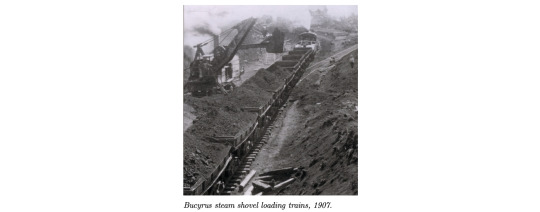
Over the life of the project seventy-seven Bucyrus and twenty-four Marion shovels laboured tirelessly on cleaving a path through the wilds of Panama. In tow with these metal workhorses were track-shifters that exhumed old rail and plopped it down anew as the ensemble of men and machines invaded deeper into the thicket of jungle. The genius of plying trains this way to scaffold the Panama Canal lay in the relentless momentum when a dozen men partook in the migration of track with haste versus the six hundred under past French fiat. Such innovation crimped labour and time to maximize productivity as idleness was anathema to progress. The systematic use of rail in the supply chain equally gave vent to a nocturnal character where by day the drums of industry boomed and by night a bouquet of workers commuted onsite and tended to the machines for repair and restock of coal. Things were always astir and never asleep. The lion’s share of controlled demolition also coincided the evening hours or midday breaks when the flight of personnel transformed worksites into a tabula rasa for Dupont dynamite. Thirty-six years after Alfred Nobel unlocked the power of nitroglycerine this substance evolved into the sine quo non of operations insofar as sixty-one million pounds of it blasted asunder the isthmus (McCullough 1977).
The Canal emblematized the jewel of empire when the might of industry descended upon this barren strip of land. As America rode the crest of the Industrial Revolution amidst the heyday of the Gilded Age with mechanical juggernauts of great calibre the project hurried along in earnest. The Cartesian method of excavation proceeding in lockstep with disposal across a constellation of fixed capital was the single most salient innovation. Pneumatic drills amongst this lot further guaranteed time was a commodity well spent which the economies of $22 million below final budget estimates evidenced (Rogers 2014). Compressed air plants of vast dimensions attended to these rigs whose boreholes at a maximum depth of fifty feet accommodated strings of dynamite. Over 725 of these contraptions perforated the landscape to fracture stubborn rock. Both churn and well drills powered by coal counted themselves amongst the company of tools used along the route as well (Giroux 2014). A choreography of diggers, blasters and haulers thereby manifested into the mainstay of this gorge linking the Atlantic and Pacific. For a measure of perspective more explosives found use in the throes of this project than the sum from America’s wars hitherto. The efficiency wrought by dynamite was made famous in the Culebra Cut.


For the Americans just as it was for the French this nine-mile stretch of dirt hung the Sword of Damocles over the Canal’s prospects. A quarter of expenses or $90m financed this chapter of excavation alone (Rogers 2014). Heavy rains waterlogged the site which landslides compounded by engulfing the lowest-hanging fruit of equipment too ponderous to escape. What made this tranche of work most daunting was the heterogeneity of soil. The unstable geology of soft shale coupled with sandstone at the Canal’s highest elevation wrought havoc on the exigency to remove 96 million cubic yards of material from the Continental Divide. In fact this very conundrum which defeated the French a decade prior would spur the creation of the Bucyrus steam shovel in its 95-ton and 105-ton incarnations as a sui generis remedy to the spectre of failure. Bref the Americans simply engineered the problem away. Whereas Paris sought to cross the isthmus with a minimal amount of digging the buccaneers in Washington set upon doing the most. The former being partial to minimalism and the latter plumping for maximalism evokes the popular stereotype of the disparity in preferences for either country: a dichotomy of macaroons and monster trucks. Facts do countenance this bon mot since France cleared 78 million cubic yards versus the 246 million by the Yankees (Herndon 1977).
0 notes
Photo

The liquefied petroleum gas (LPG) tanker Clipper Wilma passing through the Gatun Locks of the Panama Canal near Colón, Panama.
4 notes
·
View notes
Text
Maersk to use rail to bypass Panama Canal amid drought | Offshore Jobs
A.P. Moller-Maersk will use trains to avoid the drought-hit Panama Canal for some of its vessels, the Danish shipping giant said as low water levels have caused one of the world’s main maritime trade routes to reduce crossings.

The Panama Canal Authority has reduced the amount and weight of vessels passing through based on current and projected water levels in Gatun Lake, the rainfall-fed principal reservoir that floats ships through the canal’s lock system, Maersk, one of the world’s largest container shipping companies, said.
The company’s OC1 service, connecting Australia and New Zealand with the U.S. east coast cities of Philadelphia and Charleston via the Panama Canal, will now create two separate loops, one Atlantic and one Pacific.
“The vessels that utilised the Panama Canal before will now omit the Panama Canal and use a “land bridge” that utilises rail to transport cargo across the 80 km (50 miles) of Panama to the other side,” the firm said in an advisory to its customers.
Panama’s drought, worsened by the El Nino weather phenomenon, has decreased transit slots at the canal, already forcing fuel tankers and grain shippers to take longer routes to avoid congestion.
Get More Info : Marex
Website : https://www.seajob.net/
Contact Us : Sailor Job
0 notes
Text
[The boats are raised and lowered through a system of locks which]relies on fresh water from Lake Gatun and another nearby reservoir to function. Every ship that passes through the canal uses 200m litres of water most of which then flows out into the sea.
The same sources also provide water for more than half of Panama’s 4.3 million inhabitants, forcing administrators to balance the demands of international shipping with the needs of the locals.
1 note
·
View note
Text
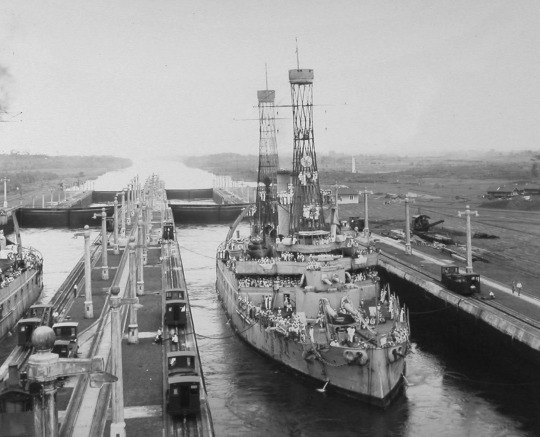
USS Kentucky BB-6 in Middle East Chamber of Gatun Locks,Panama Going South July 7, 1919 Nara Image
19 notes
·
View notes
Text

USS Houston (CA-30) passes through the Gatun locks, Panama canal, on July 11, 1934. President Franklin D. Roosevelt and his party on board. Members of the presidential party are visible near turret #2. She was en route from Annapolis, Maryland to Portland, Oregon. This was the first passage through the canal by a president of the United States while in office.
NHHC: 80-G-455963
#USS Houston (CA-30)#USS Houston (CL-30)#USS Houston#Northampton Class#Cruiser#Panama Canal#Panama#July#1934#interwar period#united states navy#us navy#navy#usn#u.s. navy#my post
40 notes
·
View notes